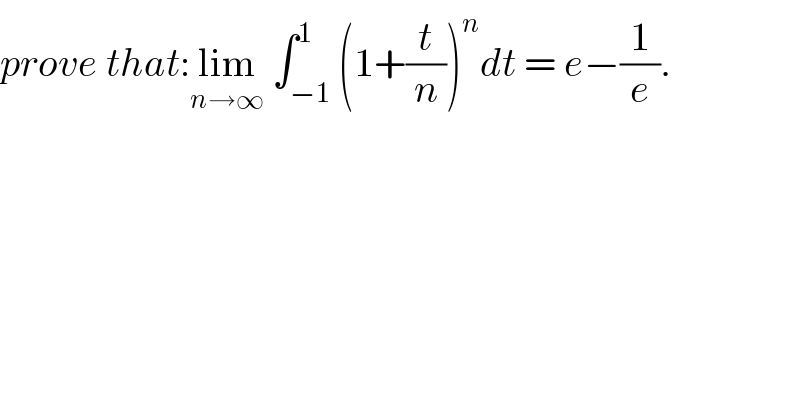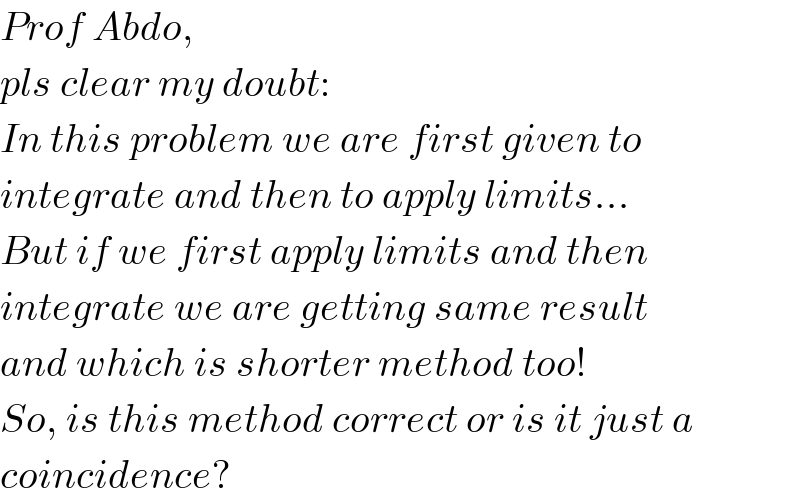Question Number 47098 by rahul 19 last updated on 04/Nov/18

Commented by rahul 19 last updated on 04/Nov/18

Commented by maxmathsup by imad last updated on 05/Nov/18

Commented by maxmathsup by imad last updated on 04/Nov/18
![let A_n = ∫_(−1) ^1 (1+(t/n))^n dt =∫_R (1+(t/n))^n χ_([−1,1]) (t)dt let f_n (t)=(1+(t/n))^n χ_([−1,1]) (t) we have lim_(n→+∞) f_n (t) =e^t χ_([−1,1]) (t) (simple convergence ) and ∣f_n (t)∣ ≤e^t ∀ t ∈[−1,1] dominent convergence give lim_(n→+∞) A_n =∫_R lim_(n→) f_n (t)dt = ∫_R e^t χ_([−1,1]) (t)dt =∫_(−1) ^1 e^t dt=[e^t ]_(−1) ^1 =e −(1/e) .](https://www.tinkutara.com/question/Q47103.png)
Commented by maxmathsup by imad last updated on 04/Nov/18
![another method let A_n = ∫_(−1) ^1 (1+(t/n))^n dt changement (t/n)=x give A_n =∫_(−(1/n)) ^(1/n) (1+x)^n ndx =n ∫_(−(1/n)) ^(1/n) (1+x)^n dx =(n/(n+1)) [(1+x)^(n+1) ]_(−(1/n)) ^(1/n) =(n/(n+1)){(1+(1/n))^(n+1) −(1−(1/n))^(n+1) } but (1+(1/n))^(n+1) =e^((n+1)ln( 1+(1/n))) but we have ln(1+(1/n))=(1/n)+o((1/n)) ⇒ (n+1)ln(1+(1/n))=((n+1)/n) +o(1) →1 (n→+∞) also (n+1)ln(1−(1/n)) =−((n+1)/n) →−1 (n→+∞) ⇒lim_(n→+∞) A_n =lim_(n→+∞) (n/(n+1))(e−e^(−1) ) ⇒ lim_(n→+∞) A_n =e −e^(−1) .](https://www.tinkutara.com/question/Q47104.png)
Commented by peter frank last updated on 04/Nov/18

Commented by rahul 19 last updated on 05/Nov/18

Commented by rahul 19 last updated on 05/Nov/18

Commented by maxmathsup by imad last updated on 06/Nov/18

Answered by tanmay.chaudhury50@gmail.com last updated on 04/Nov/18
![I=∫(1+(t/n))^n dt k=1+(t/n) dk=(dt/n) ∫k^n ×ndk n×(k^(n+1) /(n+1))+c_1 so the intregsl is (n/(n+1))×∣(1+(t/n))^(n+1) ∣_(−1) ^1 (n/(n+1))[(1+(1/n))^(n+1) −(1−(1/n))^(n+1) now apply limit lim_(n→∞) (1/(1+(1/n)))[(1+(1/n))^(n+1) −(1−(1/n))^(n+1) ] =lim_(n→∞) (1/(1+(1/n)))×[lim_(n→∞) (1+(1/n))×lim_(n→∞) (1+(1/n))^n −lim_(n→∞[) (1−(1/n))×lim_(n→∞) (1−(1/n))^n ] =(1/(1+0))×[(1+0)×e−(1−0)×e^(−1) ] =(e−(1/e)) first intregation then limit done pls check... now formula lip_(n→∞) =lil_(n→∞) ×li_(n→∞) nz=li_(n→∞) =li_(y→0) z=e li_(n→∞) lnp=li_(n→∞) w=(1/n) li_(w→0) =li_(w→0)](https://www.tinkutara.com/question/Q47100.png)
Commented by rahul 19 last updated on 05/Nov/18
thanks sir ����
